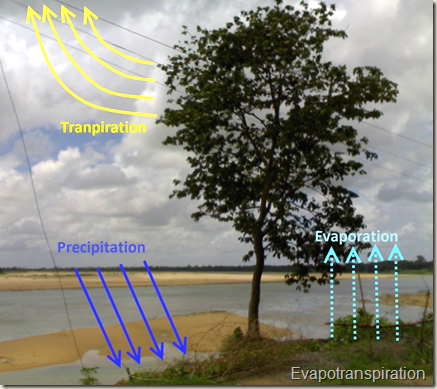Evapotranspiration is the combined loss of water from earth surface and crop by vaporisation. Crops uses water for transpiration and evaporation activates. During the growing period of a crop,there is a continuous movement of water from soil into the roots, up the stems and leaves, and out of the leaves to the atmosphere. Only a very small portion (less than 2 per cent) of water absorbed by the roots is retained in the plant and the rest of the absorbed water, after performing its tasks, gets evaporated to the atmosphere mainly through the leaves and stem. This process is called transpiration. In addition, some water gets evaporated to the atmosphere directly from the adjacent soil and water surfaces and from the surfaces of the plant leaves (i.e., the intercepted precipitation on the plant foliage). The water needs of a crop thus consists of transpiration and evaporation and is called evapotranspiration or consumptive use.
Consumptive use is the sum of water need of crop and volume of transpirated in a specific time. Consumptive use is also described as amount of water needed to meet the water loss through evapotranspiration. It generally applies to a crop but can be extended to a field, farm, project or even a valley. Consumptive use is generally measured as volume per unit area or simply as the depth of water on the irrigated area. Knowledge of consumptive use helps determine irrigation requirement at the farm which should, obviously, be the difference between the consumptive use and the effective precipitation.
Evapotranspiration is dependent on following conditions
1.Temperature
2.Daylight Hour
3.Humidity
4.Wind Movement
5.Type of Crop
6.Stage of Growth of Crop
7.Soil moisture depletion
8.Physical and chemical properties of soil
Evapotranspiration is dependent on following conditions
1.Temperature
2.Daylight Hour
3.Humidity
4.Wind Movement
5.Type of Crop
6.Stage of Growth of Crop
7.Soil moisture depletion
8.Physical and chemical properties of soil
For example, in a sunny and hot climate, crops need more water per day than in a cloudy and cool climate. Similarly, crops like rice or sugarcane need more water than crops like beans and wheat. Also, fully grown crops need more water than crops which have been just planted.

